Essay: Population Policy in Australia, Quotas, and Merit
VerifiedAdded on 2022/12/05
|8
|2033
|128
Essay
AI Summary
This essay critically analyzes key debates surrounding 'merit,' 'quotas,' and 'targets' within the context of Australian population policy, with a specific focus on the underlying assumptions of each concept. It explores the application of quotas, particularly gender quotas, in the Australian Parliament and discusses the merits and demerits associated with such systems. The essay also examines how these issues have evolved over time and in different cultural contexts, including a comparison with India's reservation system. The discussion includes the stances of different political parties in Australia, such as the Australian Labour Party and the Liberal-Nationals Coalition, on gender quotas and affirmative action. The paper highlights the importance of increasing female participation in the Australian Federal Parliament and discusses the need for quota systems to improve this condition. The conclusion emphasizes the importance of a more inclusive political environment in Australia and the role of quotas in achieving this.
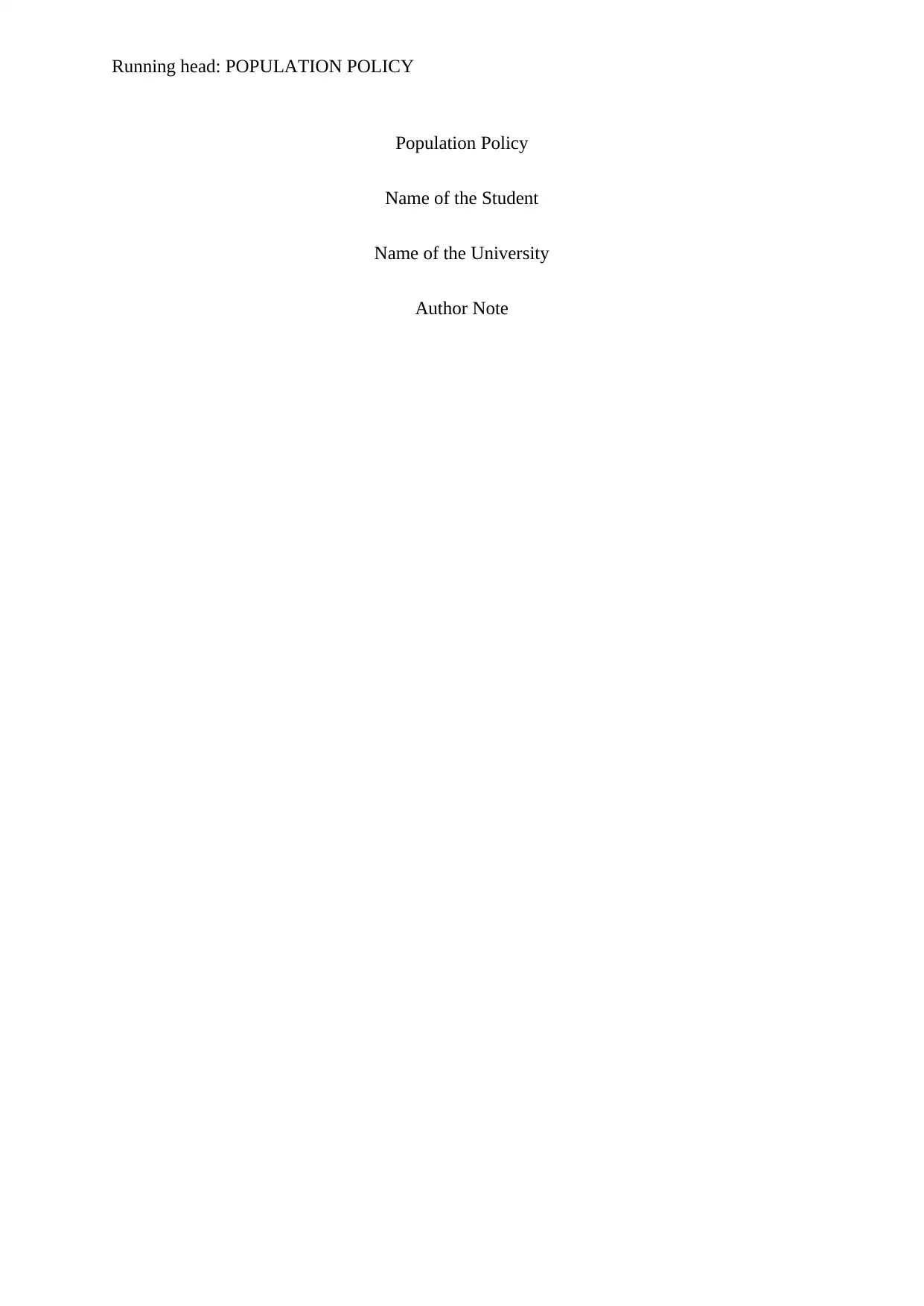
Running head: POPULATION POLICY
Population Policy
Name of the Student
Name of the University
Author Note
Population Policy
Name of the Student
Name of the University
Author Note
Paraphrase This Document
Need a fresh take? Get an instant paraphrase of this document with our AI Paraphraser
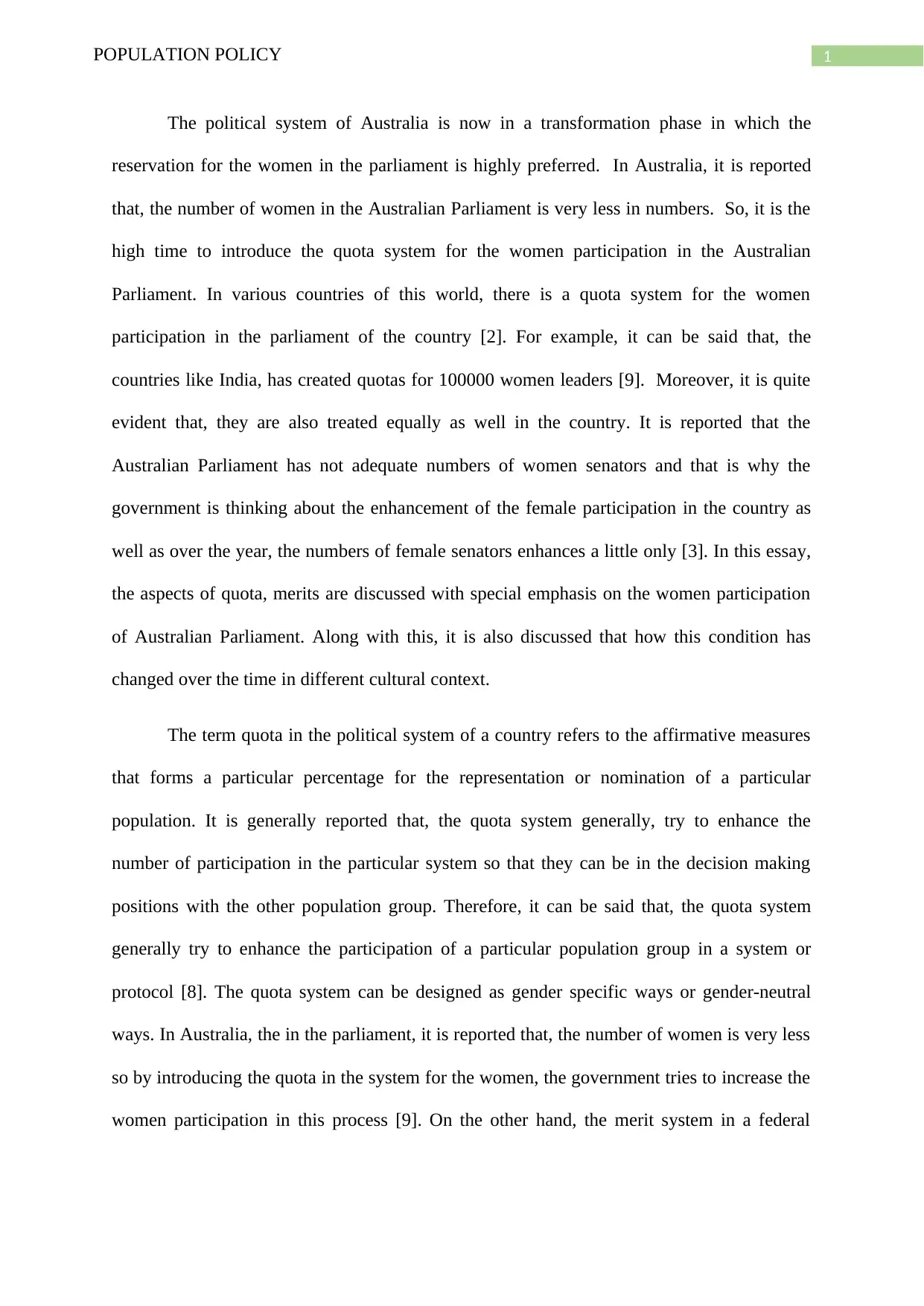
1POPULATION POLICY
The political system of Australia is now in a transformation phase in which the
reservation for the women in the parliament is highly preferred. In Australia, it is reported
that, the number of women in the Australian Parliament is very less in numbers. So, it is the
high time to introduce the quota system for the women participation in the Australian
Parliament. In various countries of this world, there is a quota system for the women
participation in the parliament of the country [2]. For example, it can be said that, the
countries like India, has created quotas for 100000 women leaders [9]. Moreover, it is quite
evident that, they are also treated equally as well in the country. It is reported that the
Australian Parliament has not adequate numbers of women senators and that is why the
government is thinking about the enhancement of the female participation in the country as
well as over the year, the numbers of female senators enhances a little only [3]. In this essay,
the aspects of quota, merits are discussed with special emphasis on the women participation
of Australian Parliament. Along with this, it is also discussed that how this condition has
changed over the time in different cultural context.
The term quota in the political system of a country refers to the affirmative measures
that forms a particular percentage for the representation or nomination of a particular
population. It is generally reported that, the quota system generally, try to enhance the
number of participation in the particular system so that they can be in the decision making
positions with the other population group. Therefore, it can be said that, the quota system
generally try to enhance the participation of a particular population group in a system or
protocol [8]. The quota system can be designed as gender specific ways or gender-neutral
ways. In Australia, the in the parliament, it is reported that, the number of women is very less
so by introducing the quota in the system for the women, the government tries to increase the
women participation in this process [9]. On the other hand, the merit system in a federal
The political system of Australia is now in a transformation phase in which the
reservation for the women in the parliament is highly preferred. In Australia, it is reported
that, the number of women in the Australian Parliament is very less in numbers. So, it is the
high time to introduce the quota system for the women participation in the Australian
Parliament. In various countries of this world, there is a quota system for the women
participation in the parliament of the country [2]. For example, it can be said that, the
countries like India, has created quotas for 100000 women leaders [9]. Moreover, it is quite
evident that, they are also treated equally as well in the country. It is reported that the
Australian Parliament has not adequate numbers of women senators and that is why the
government is thinking about the enhancement of the female participation in the country as
well as over the year, the numbers of female senators enhances a little only [3]. In this essay,
the aspects of quota, merits are discussed with special emphasis on the women participation
of Australian Parliament. Along with this, it is also discussed that how this condition has
changed over the time in different cultural context.
The term quota in the political system of a country refers to the affirmative measures
that forms a particular percentage for the representation or nomination of a particular
population. It is generally reported that, the quota system generally, try to enhance the
number of participation in the particular system so that they can be in the decision making
positions with the other population group. Therefore, it can be said that, the quota system
generally try to enhance the participation of a particular population group in a system or
protocol [8]. The quota system can be designed as gender specific ways or gender-neutral
ways. In Australia, the in the parliament, it is reported that, the number of women is very less
so by introducing the quota in the system for the women, the government tries to increase the
women participation in this process [9]. On the other hand, the merit system in a federal
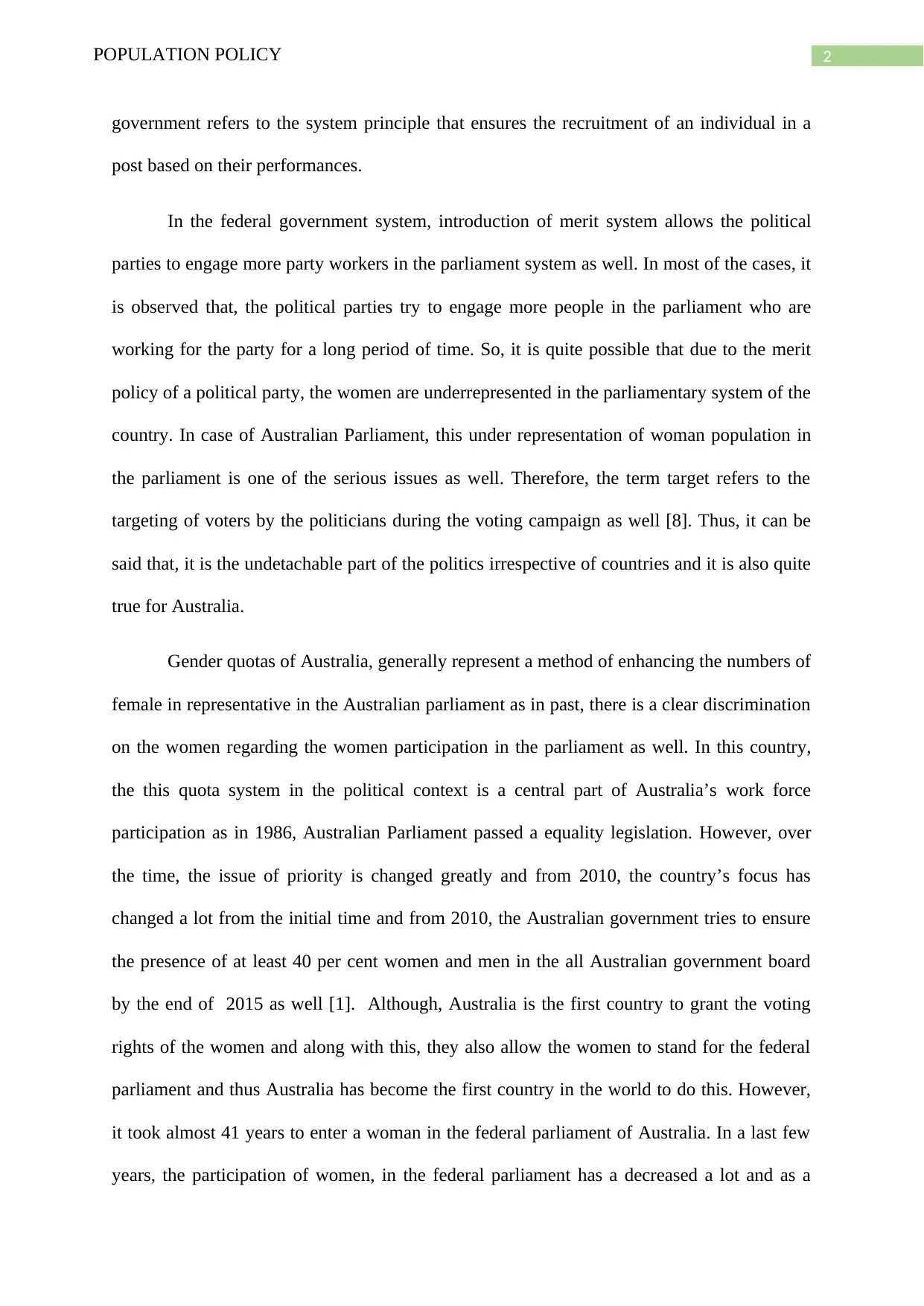
2POPULATION POLICY
government refers to the system principle that ensures the recruitment of an individual in a
post based on their performances.
In the federal government system, introduction of merit system allows the political
parties to engage more party workers in the parliament system as well. In most of the cases, it
is observed that, the political parties try to engage more people in the parliament who are
working for the party for a long period of time. So, it is quite possible that due to the merit
policy of a political party, the women are underrepresented in the parliamentary system of the
country. In case of Australian Parliament, this under representation of woman population in
the parliament is one of the serious issues as well. Therefore, the term target refers to the
targeting of voters by the politicians during the voting campaign as well [8]. Thus, it can be
said that, it is the undetachable part of the politics irrespective of countries and it is also quite
true for Australia.
Gender quotas of Australia, generally represent a method of enhancing the numbers of
female in representative in the Australian parliament as in past, there is a clear discrimination
on the women regarding the women participation in the parliament as well. In this country,
the this quota system in the political context is a central part of Australia’s work force
participation as in 1986, Australian Parliament passed a equality legislation. However, over
the time, the issue of priority is changed greatly and from 2010, the country’s focus has
changed a lot from the initial time and from 2010, the Australian government tries to ensure
the presence of at least 40 per cent women and men in the all Australian government board
by the end of 2015 as well [1]. Although, Australia is the first country to grant the voting
rights of the women and along with this, they also allow the women to stand for the federal
parliament and thus Australia has become the first country in the world to do this. However,
it took almost 41 years to enter a woman in the federal parliament of Australia. In a last few
years, the participation of women, in the federal parliament has a decreased a lot and as a
government refers to the system principle that ensures the recruitment of an individual in a
post based on their performances.
In the federal government system, introduction of merit system allows the political
parties to engage more party workers in the parliament system as well. In most of the cases, it
is observed that, the political parties try to engage more people in the parliament who are
working for the party for a long period of time. So, it is quite possible that due to the merit
policy of a political party, the women are underrepresented in the parliamentary system of the
country. In case of Australian Parliament, this under representation of woman population in
the parliament is one of the serious issues as well. Therefore, the term target refers to the
targeting of voters by the politicians during the voting campaign as well [8]. Thus, it can be
said that, it is the undetachable part of the politics irrespective of countries and it is also quite
true for Australia.
Gender quotas of Australia, generally represent a method of enhancing the numbers of
female in representative in the Australian parliament as in past, there is a clear discrimination
on the women regarding the women participation in the parliament as well. In this country,
the this quota system in the political context is a central part of Australia’s work force
participation as in 1986, Australian Parliament passed a equality legislation. However, over
the time, the issue of priority is changed greatly and from 2010, the country’s focus has
changed a lot from the initial time and from 2010, the Australian government tries to ensure
the presence of at least 40 per cent women and men in the all Australian government board
by the end of 2015 as well [1]. Although, Australia is the first country to grant the voting
rights of the women and along with this, they also allow the women to stand for the federal
parliament and thus Australia has become the first country in the world to do this. However,
it took almost 41 years to enter a woman in the federal parliament of Australia. In a last few
years, the participation of women, in the federal parliament has a decreased a lot and as a
⊘ This is a preview!⊘
Do you want full access?
Subscribe today to unlock all pages.

Trusted by 1+ million students worldwide
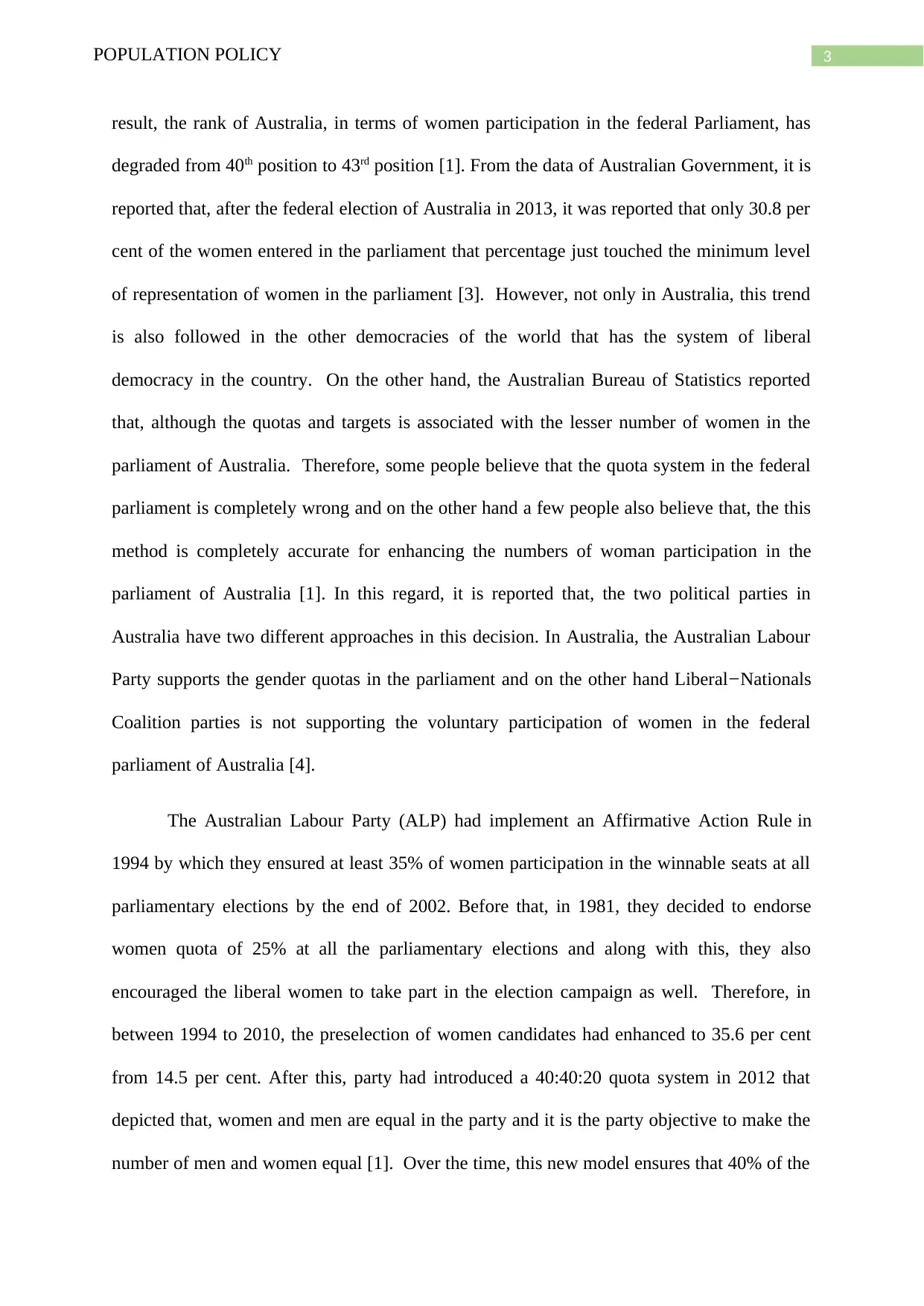
3POPULATION POLICY
result, the rank of Australia, in terms of women participation in the federal Parliament, has
degraded from 40th position to 43rd position [1]. From the data of Australian Government, it is
reported that, after the federal election of Australia in 2013, it was reported that only 30.8 per
cent of the women entered in the parliament that percentage just touched the minimum level
of representation of women in the parliament [3]. However, not only in Australia, this trend
is also followed in the other democracies of the world that has the system of liberal
democracy in the country. On the other hand, the Australian Bureau of Statistics reported
that, although the quotas and targets is associated with the lesser number of women in the
parliament of Australia. Therefore, some people believe that the quota system in the federal
parliament is completely wrong and on the other hand a few people also believe that, the this
method is completely accurate for enhancing the numbers of woman participation in the
parliament of Australia [1]. In this regard, it is reported that, the two political parties in
Australia have two different approaches in this decision. In Australia, the Australian Labour
Party supports the gender quotas in the parliament and on the other hand Liberal ̶ Nationals
Coalition parties is not supporting the voluntary participation of women in the federal
parliament of Australia [4].
The Australian Labour Party (ALP) had implement an Affirmative Action Rule in
1994 by which they ensured at least 35% of women participation in the winnable seats at all
parliamentary elections by the end of 2002. Before that, in 1981, they decided to endorse
women quota of 25% at all the parliamentary elections and along with this, they also
encouraged the liberal women to take part in the election campaign as well. Therefore, in
between 1994 to 2010, the preselection of women candidates had enhanced to 35.6 per cent
from 14.5 per cent. After this, party had introduced a 40:40:20 quota system in 2012 that
depicted that, women and men are equal in the party and it is the party objective to make the
number of men and women equal [1]. Over the time, this new model ensures that 40% of the
result, the rank of Australia, in terms of women participation in the federal Parliament, has
degraded from 40th position to 43rd position [1]. From the data of Australian Government, it is
reported that, after the federal election of Australia in 2013, it was reported that only 30.8 per
cent of the women entered in the parliament that percentage just touched the minimum level
of representation of women in the parliament [3]. However, not only in Australia, this trend
is also followed in the other democracies of the world that has the system of liberal
democracy in the country. On the other hand, the Australian Bureau of Statistics reported
that, although the quotas and targets is associated with the lesser number of women in the
parliament of Australia. Therefore, some people believe that the quota system in the federal
parliament is completely wrong and on the other hand a few people also believe that, the this
method is completely accurate for enhancing the numbers of woman participation in the
parliament of Australia [1]. In this regard, it is reported that, the two political parties in
Australia have two different approaches in this decision. In Australia, the Australian Labour
Party supports the gender quotas in the parliament and on the other hand Liberal ̶ Nationals
Coalition parties is not supporting the voluntary participation of women in the federal
parliament of Australia [4].
The Australian Labour Party (ALP) had implement an Affirmative Action Rule in
1994 by which they ensured at least 35% of women participation in the winnable seats at all
parliamentary elections by the end of 2002. Before that, in 1981, they decided to endorse
women quota of 25% at all the parliamentary elections and along with this, they also
encouraged the liberal women to take part in the election campaign as well. Therefore, in
between 1994 to 2010, the preselection of women candidates had enhanced to 35.6 per cent
from 14.5 per cent. After this, party had introduced a 40:40:20 quota system in 2012 that
depicted that, women and men are equal in the party and it is the party objective to make the
number of men and women equal [1]. Over the time, this new model ensures that 40% of the
Paraphrase This Document
Need a fresh take? Get an instant paraphrase of this document with our AI Paraphraser
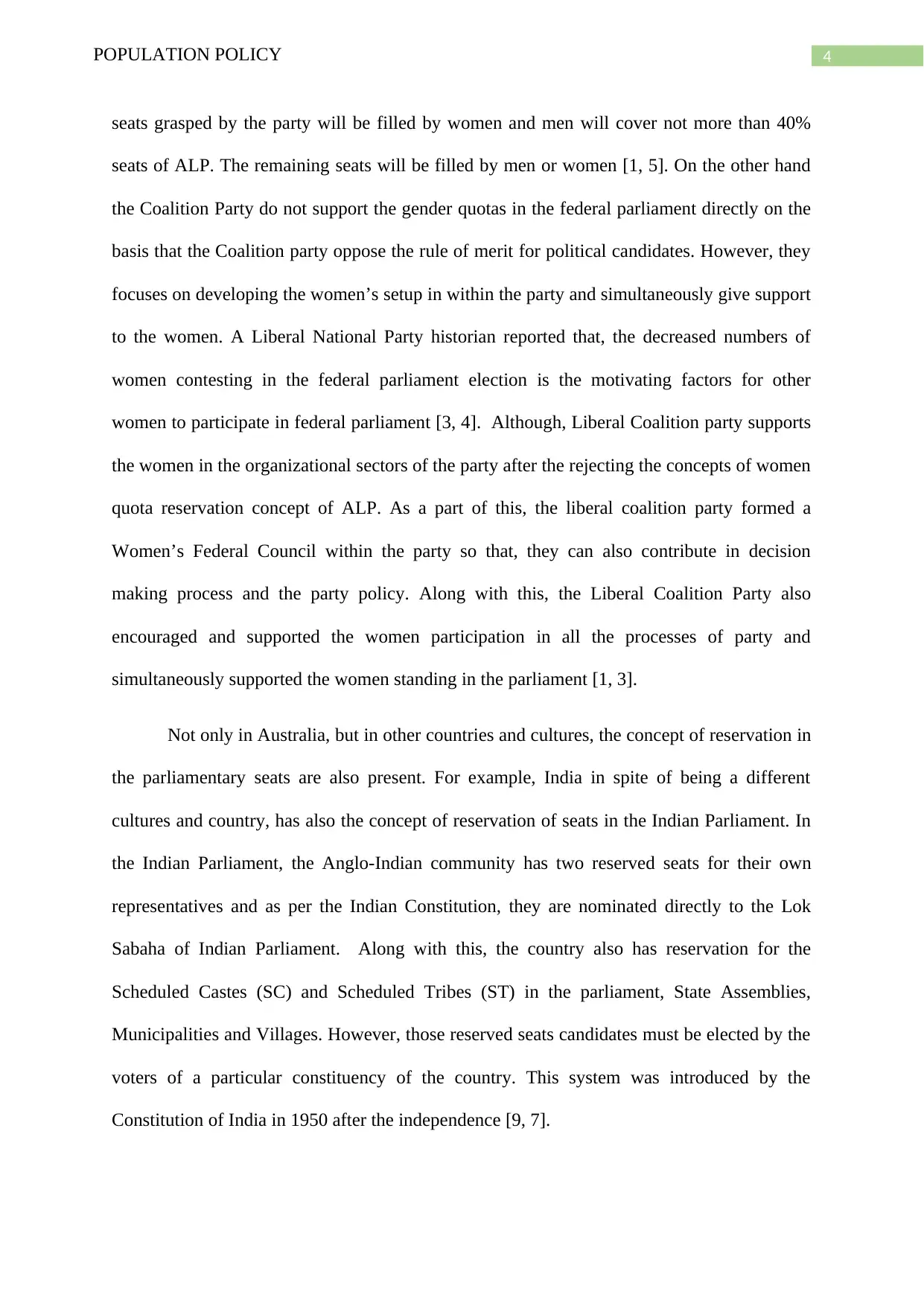
4POPULATION POLICY
seats grasped by the party will be filled by women and men will cover not more than 40%
seats of ALP. The remaining seats will be filled by men or women [1, 5]. On the other hand
the Coalition Party do not support the gender quotas in the federal parliament directly on the
basis that the Coalition party oppose the rule of merit for political candidates. However, they
focuses on developing the women’s setup in within the party and simultaneously give support
to the women. A Liberal National Party historian reported that, the decreased numbers of
women contesting in the federal parliament election is the motivating factors for other
women to participate in federal parliament [3, 4]. Although, Liberal Coalition party supports
the women in the organizational sectors of the party after the rejecting the concepts of women
quota reservation concept of ALP. As a part of this, the liberal coalition party formed a
Women’s Federal Council within the party so that, they can also contribute in decision
making process and the party policy. Along with this, the Liberal Coalition Party also
encouraged and supported the women participation in all the processes of party and
simultaneously supported the women standing in the parliament [1, 3].
Not only in Australia, but in other countries and cultures, the concept of reservation in
the parliamentary seats are also present. For example, India in spite of being a different
cultures and country, has also the concept of reservation of seats in the Indian Parliament. In
the Indian Parliament, the Anglo-Indian community has two reserved seats for their own
representatives and as per the Indian Constitution, they are nominated directly to the Lok
Sabaha of Indian Parliament. Along with this, the country also has reservation for the
Scheduled Castes (SC) and Scheduled Tribes (ST) in the parliament, State Assemblies,
Municipalities and Villages. However, those reserved seats candidates must be elected by the
voters of a particular constituency of the country. This system was introduced by the
Constitution of India in 1950 after the independence [9, 7].
seats grasped by the party will be filled by women and men will cover not more than 40%
seats of ALP. The remaining seats will be filled by men or women [1, 5]. On the other hand
the Coalition Party do not support the gender quotas in the federal parliament directly on the
basis that the Coalition party oppose the rule of merit for political candidates. However, they
focuses on developing the women’s setup in within the party and simultaneously give support
to the women. A Liberal National Party historian reported that, the decreased numbers of
women contesting in the federal parliament election is the motivating factors for other
women to participate in federal parliament [3, 4]. Although, Liberal Coalition party supports
the women in the organizational sectors of the party after the rejecting the concepts of women
quota reservation concept of ALP. As a part of this, the liberal coalition party formed a
Women’s Federal Council within the party so that, they can also contribute in decision
making process and the party policy. Along with this, the Liberal Coalition Party also
encouraged and supported the women participation in all the processes of party and
simultaneously supported the women standing in the parliament [1, 3].
Not only in Australia, but in other countries and cultures, the concept of reservation in
the parliamentary seats are also present. For example, India in spite of being a different
cultures and country, has also the concept of reservation of seats in the Indian Parliament. In
the Indian Parliament, the Anglo-Indian community has two reserved seats for their own
representatives and as per the Indian Constitution, they are nominated directly to the Lok
Sabaha of Indian Parliament. Along with this, the country also has reservation for the
Scheduled Castes (SC) and Scheduled Tribes (ST) in the parliament, State Assemblies,
Municipalities and Villages. However, those reserved seats candidates must be elected by the
voters of a particular constituency of the country. This system was introduced by the
Constitution of India in 1950 after the independence [9, 7].
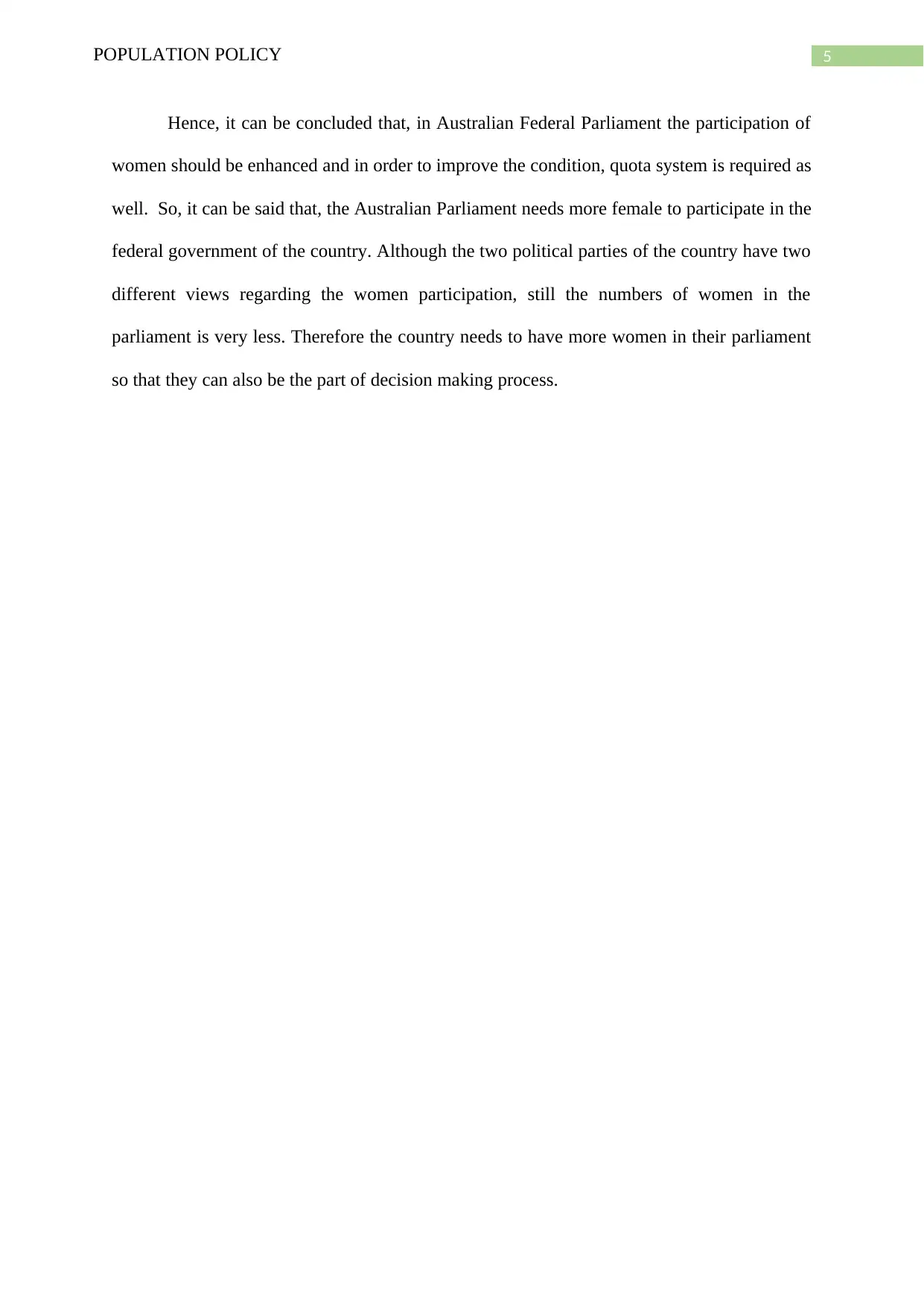
5POPULATION POLICY
Hence, it can be concluded that, in Australian Federal Parliament the participation of
women should be enhanced and in order to improve the condition, quota system is required as
well. So, it can be said that, the Australian Parliament needs more female to participate in the
federal government of the country. Although the two political parties of the country have two
different views regarding the women participation, still the numbers of women in the
parliament is very less. Therefore the country needs to have more women in their parliament
so that they can also be the part of decision making process.
Hence, it can be concluded that, in Australian Federal Parliament the participation of
women should be enhanced and in order to improve the condition, quota system is required as
well. So, it can be said that, the Australian Parliament needs more female to participate in the
federal government of the country. Although the two political parties of the country have two
different views regarding the women participation, still the numbers of women in the
parliament is very less. Therefore the country needs to have more women in their parliament
so that they can also be the part of decision making process.
⊘ This is a preview!⊘
Do you want full access?
Subscribe today to unlock all pages.

Trusted by 1+ million students worldwide
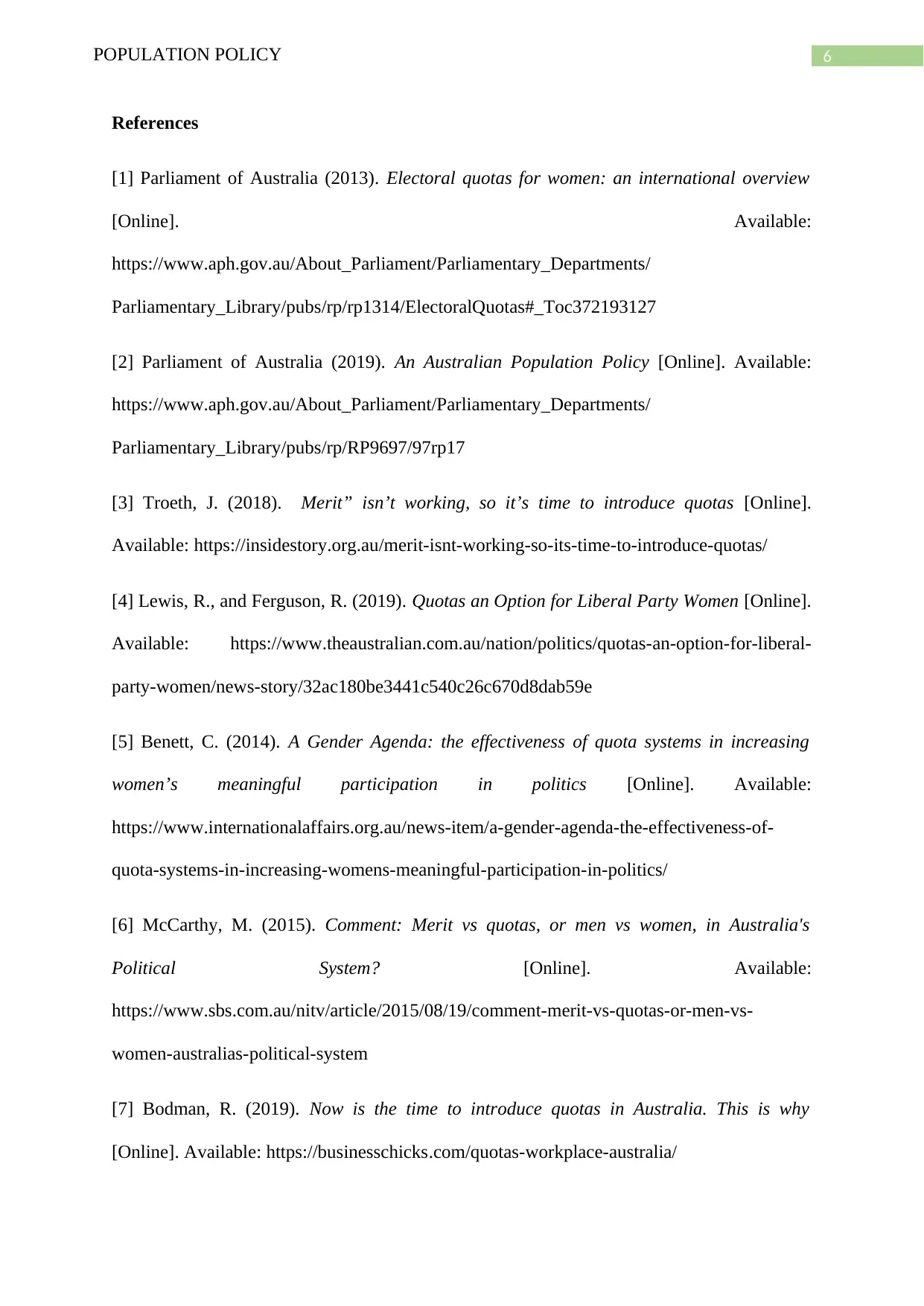
6POPULATION POLICY
References
[1] Parliament of Australia (2013). Electoral quotas for women: an international overview
[Online]. Available:
https://www.aph.gov.au/About_Parliament/Parliamentary_Departments/
Parliamentary_Library/pubs/rp/rp1314/ElectoralQuotas#_Toc372193127
[2] Parliament of Australia (2019). An Australian Population Policy [Online]. Available:
https://www.aph.gov.au/About_Parliament/Parliamentary_Departments/
Parliamentary_Library/pubs/rp/RP9697/97rp17
[3] Troeth, J. (2018). Merit” isn’t working, so it’s time to introduce quotas [Online].
Available: https://insidestory.org.au/merit-isnt-working-so-its-time-to-introduce-quotas/
[4] Lewis, R., and Ferguson, R. (2019). Quotas an Option for Liberal Party Women [Online].
Available: https://www.theaustralian.com.au/nation/politics/quotas-an-option-for-liberal-
party-women/news-story/32ac180be3441c540c26c670d8dab59e
[5] Benett, C. (2014). A Gender Agenda: the effectiveness of quota systems in increasing
women’s meaningful participation in politics [Online]. Available:
https://www.internationalaffairs.org.au/news-item/a-gender-agenda-the-effectiveness-of-
quota-systems-in-increasing-womens-meaningful-participation-in-politics/
[6] McCarthy, M. (2015). Comment: Merit vs quotas, or men vs women, in Australia's
Political System? [Online]. Available:
https://www.sbs.com.au/nitv/article/2015/08/19/comment-merit-vs-quotas-or-men-vs-
women-australias-political-system
[7] Bodman, R. (2019). Now is the time to introduce quotas in Australia. This is why
[Online]. Available: https://businesschicks.com/quotas-workplace-australia/
References
[1] Parliament of Australia (2013). Electoral quotas for women: an international overview
[Online]. Available:
https://www.aph.gov.au/About_Parliament/Parliamentary_Departments/
Parliamentary_Library/pubs/rp/rp1314/ElectoralQuotas#_Toc372193127
[2] Parliament of Australia (2019). An Australian Population Policy [Online]. Available:
https://www.aph.gov.au/About_Parliament/Parliamentary_Departments/
Parliamentary_Library/pubs/rp/RP9697/97rp17
[3] Troeth, J. (2018). Merit” isn’t working, so it’s time to introduce quotas [Online].
Available: https://insidestory.org.au/merit-isnt-working-so-its-time-to-introduce-quotas/
[4] Lewis, R., and Ferguson, R. (2019). Quotas an Option for Liberal Party Women [Online].
Available: https://www.theaustralian.com.au/nation/politics/quotas-an-option-for-liberal-
party-women/news-story/32ac180be3441c540c26c670d8dab59e
[5] Benett, C. (2014). A Gender Agenda: the effectiveness of quota systems in increasing
women’s meaningful participation in politics [Online]. Available:
https://www.internationalaffairs.org.au/news-item/a-gender-agenda-the-effectiveness-of-
quota-systems-in-increasing-womens-meaningful-participation-in-politics/
[6] McCarthy, M. (2015). Comment: Merit vs quotas, or men vs women, in Australia's
Political System? [Online]. Available:
https://www.sbs.com.au/nitv/article/2015/08/19/comment-merit-vs-quotas-or-men-vs-
women-australias-political-system
[7] Bodman, R. (2019). Now is the time to introduce quotas in Australia. This is why
[Online]. Available: https://businesschicks.com/quotas-workplace-australia/
Paraphrase This Document
Need a fresh take? Get an instant paraphrase of this document with our AI Paraphraser
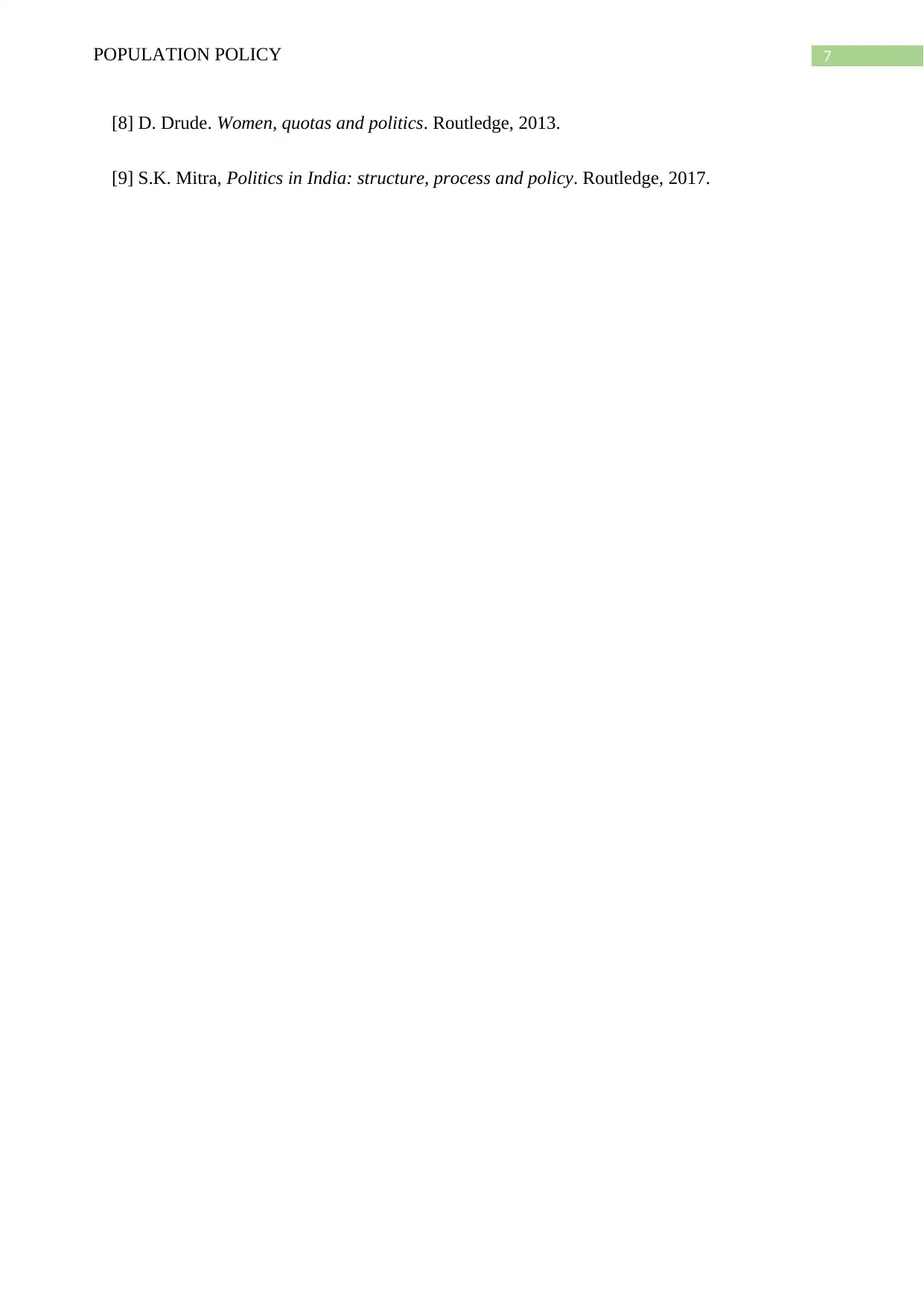
7POPULATION POLICY
[8] D. Drude. Women, quotas and politics. Routledge, 2013.
[9] S.K. Mitra, Politics in India: structure, process and policy. Routledge, 2017.
[8] D. Drude. Women, quotas and politics. Routledge, 2013.
[9] S.K. Mitra, Politics in India: structure, process and policy. Routledge, 2017.
1 out of 8
Related Documents
Your All-in-One AI-Powered Toolkit for Academic Success.
+13062052269
info@desklib.com
Available 24*7 on WhatsApp / Email
![[object Object]](/_next/static/media/star-bottom.7253800d.svg)
Unlock your academic potential
Copyright © 2020–2025 A2Z Services. All Rights Reserved. Developed and managed by ZUCOL.





